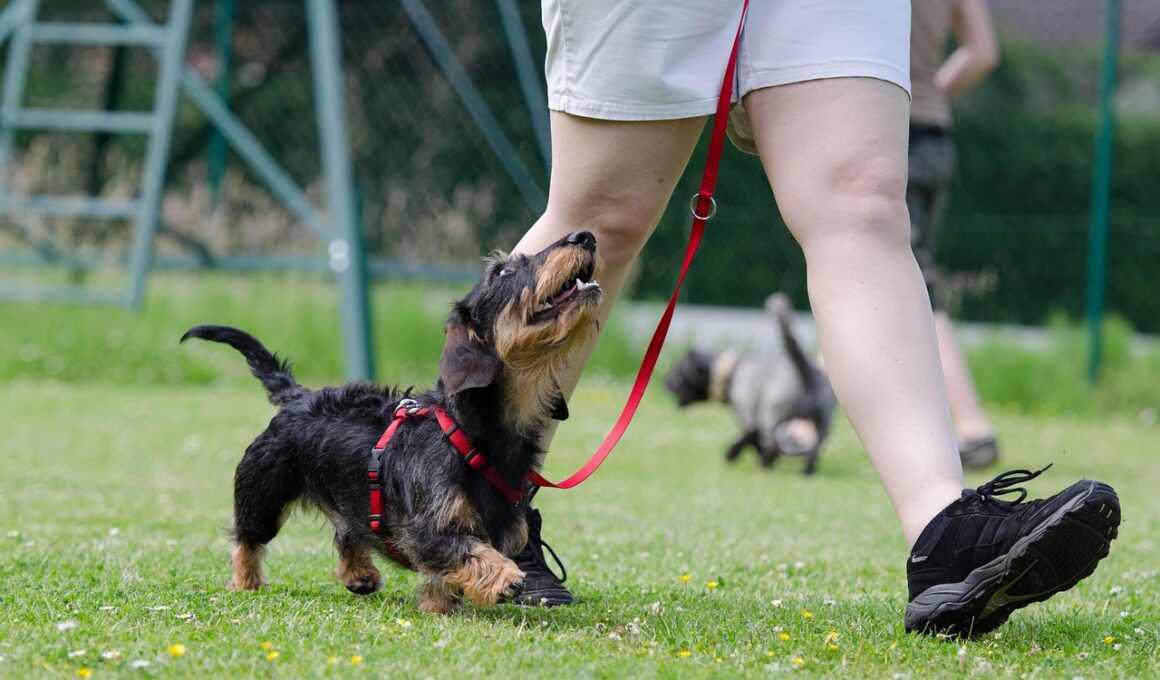How to Measure Progress Using Speed Bumpers in Training
Dog training is essential for developing well-mannered pets, and speed bumpers can aid significantly in this process. Speed bumpers are specialized training tools designed to improve a dog’s agility and obedience. Training with speed bumpers involves teaching your dog to navigate past obstacles, which enhances observation, coordination, and speed. It’s vital to incorporate these bumpers appropriately into your dog’s training regimen to measure progress effectively. For beginners, you could start by introducing your dog to the bumpers in a familiar environment. This comfort will help your dog be more willing to experiment and explore. Gradually increase the difficulty by moving bumpers into new positions. Keeping a consistent schedule for training sessions ensures that the dog builds muscle memory associated with navigating the bumpers effectively. Furthermore, be sure to use positive reinforcement effectively, Reward your dog with praise or treats whenever they successfully maneuver around the bumpers. This achievable reward system helps motivate your dog and makes training more enjoyable for both parties. If your dog struggles, don’t hesitate to reset and simplify the training to maintain a positive experience during practice.
Tracking progress over time is crucial. A simple way to measure improvements is by timing your dog’s efforts as they navigate the bumpers. Use a stopwatch to observe how quickly your dog can complete the course. Record these times and monitor changes over weeks or months. If you notice a decrease in time, that indicates improved performance and skill. On the other hand, if times are inconsistent, consider reassessing your training methods or environment, as changes might be necessary to maintain progress. In addition to timing, observing your dog during training sessions is also valuable. Look for cues in their behavior, such as increased focus, enthusiasm, and eagerness to engage with the bumpers. It’s normal to have ups and downs in training, so maintain a journal documenting both days of success and challenges. This documentation allows you to spot patterns in your dog’s learning and response to training techniques. You might also obtain insights into which exercises benefit your dog the most. Proper communication with your dog fosters an increased bond, which can lead to significant progress in training, showcasing the importance of a positive relationship.
Incorporate Varied Training Sessions
To ensure that your dog stays engaged, it’s essential to incorporate variety into your training sessions. Varying the training regimen can prevent boredom and keep the dog focused on the tasks. One way to do this is by changing the layout of the speed bumpers. Moving them to different locations can encourage your dog to think creatively and adapt to new challenges. You could also utilize various commands or cues to enhance understanding during the training process. For example, use specific commands when training your dog to weave through the bumpers or jump over them. Offering diverse experiences will encourage faster learning and a greater sense of accomplishment. Also, consider organizing occasional obstacle courses that incorporate speed bumpers alongside other training equipment. This can create an exciting and dynamic environment, promoting more enjoyable practice sessions. Always remember to adapt the training to your dog’s specific strengths and weaknesses. Making slight adjustments to the speed bumpers’ arrangement or combination can significantly impact the effectiveness of your training sessions over time.
In addition to the physical training aspect, mental stimulation is also important. Engage your dog’s mind by introducing problem-solving exercises that challenge them through the speed bumpers. You could create simple puzzles that require your dog to find hidden rewards while traversing the bumpers. Mixing these exercises into your training sessions enhances their interest in participating and increases their learning rate. Additionally, using toys or treats strategically placed near or around the bumpers can motivate your dog to approach them with enthusiasm. Watching closely for their reactions can also provide you with feedback on how invested they are in the training. Utilize their favorite toys or high-value treats to encourage accomplishment. These elements aid in creating an engaging atmosphere where your dog feels encouraged to try. Monitor any behavioral changes to determine if the exercises resonate with your dog and push for success. Allow them to repeat exercises multiple times to bolster their confidence and sense of familiarity with the training. This consistent repetition further cements their learning and leads to measurable progress.
Refining Skills and Techniques
As your dog becomes more adept at handling speed bumpers, refining specific skills and techniques becomes important. Focus on enhancing precise movements, speed, and agility in navigating through and around the bumpers. Break down each maneuver into simple steps to simplify learning. For example, start with encouraging slow movements around the bumpers before gradually increasing speed as your dog gains confidence. Observing your dog’s method of approach can help identify areas for improvement. Some common techniques include teaching commands such as ‘bring it’ or ‘over,’ which can help guide your dog through obstacle courses. When they master individual commands, you can later combine them into sequences to form larger and more complex training scenarios. Positive reinforcement remains crucial, and it enables seamless progression by providing rewards for accomplished tasks. Continuously adjusting the speed bumpers’ layout and difficulty will foster the desired skill set. You may also consult professional trainers or experienced dog owners for insights on improving your technique with speed bumpers in training. Consistent practice leads to more refined skills over time.
Another essential aspect is ongoing mastery and preparation for future challenges. Assess your dog’s comfort and efficiency with speed bumpers throughout your training journey. When you consistently observe satisfactory progress and impressive skills, consider diversifying challenges further. Introducing new tasks will help elevate your training to the next level. This could include timing your dog against competing teams for fun and practical experience. You can set up a mini-competition in a safe environment with friends and their dogs. This setup encourages excitement and motivation while practicing previous techniques. Creative rewards such as certificates or ribbons can elevate this competition. Should your dog show possibilities for future competitions, engage them in more structured events. Trends among dog training include agility and obedience competitions that could showcase your dog’s successful training with speed bumpers. Motivating your dog through challenges keeps the training dynamic and enjoyable. Keep communicating with your dog to strengthen the bond. It leads to long-term commitment in both training and competition, ultimately resulting in well-adjusted, expertly trained pets ready for a positive dog lifestyle.
Conclusion: Celebrating Achievements in Training
Celebrating milestones in your dog’s training journey with speed bumpers is just as crucial as the training itself. Acknowledging improvements and accomplishments boosts both your and your dog’s confidence, creating a positive reinforcement loop. When your dog achieves a skill or a milestone, celebrate the effort with enthusiasm—a simple pat on the back, vocal praises, or fun playtime can go a long way. These moments reinforce the bond you share. Over time, this recognition lays the foundation for a lifelong partnership. Consider organizing gatherings or playdates with other dog owners to build a supportive training network. Sharing experiences enhances motivation for both owner and pup while turning the mundane tasks into enjoyable events. Consistent practice alongside friends can lead to different perspectives regarding techniques, ultimately leading to more effective training sessions. Keep fostering your dog’s growth, and explore other aspects of their potential. In conclusion, the journey of measuring progress using speed bumpers can truly enrich the bond you share with your dog, leading to improved skills and lasting memories throughout your training adventures.


